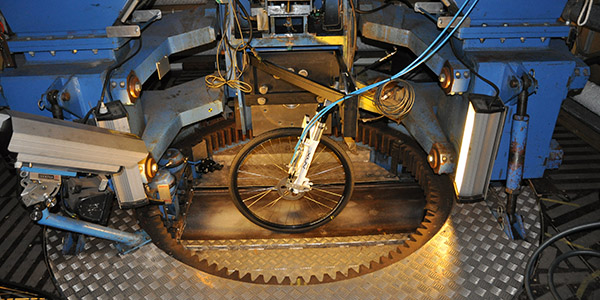Under what circumstances might cyclists lose tyre grip? What actions could then be taken to prevent a crash? The Swedish National Road and Transport Research Institute is currently developing a theoretical model of the behaviour of bicycle tyres during braking and steering in different situations and on different surfaces.

“What we have started at VTI is fundamental and revolutionary research.” Photo: Mattias Hjort
Researchers Anna Niska and Mattias Hjort speak about creating a “magic formula”. This would provide important input to bicycle simulations, and the formula would also be very useful in, for instance, the development of anti-lock braking systems for bicycles. The idea is also that road managers will eventually be able to benefit from the research results, and that the new knowledge might also be used for consumer information.
In previous projects, Anna Niska and Mattias Hjort have analysed ice friction data on bicycle tyres. Those measurements demonstrated significant differences between studded tyres and tyres without studs, but also noticed significant differences between different brands of studded bicycle tyres.
– For instance, it is not as simple as saying “the more studs the better”, Anna Niska notes.
By trying to develop the “magic formula” mentioned above, Anna Niska and Mattias Hjort are now taking research on bicycle tyres and road friction further forward. Measurements are carried out at VTI’s stationary tyre testing facility in Linköping, known to its users as “the long track”.
– At VTI we do have a long history of measuring the properties of roads and tyres, Mattias Hjort observes.
Growing interest
Until relatively recently, the focus of the test programme has been on four-wheel vehicles, not two-wheelers. However, interest in the safety of cyclists in road traffic has increased during recent years, since the statistics of road traffic accidents involving cyclists show a less favourable development than those of other road user groups. This is also the reason for the sudden availability of finance for this type of research, which was previously lacking.
Would it not be possible simply to apply results of tests involving four-wheel vehicles to two-wheelers?
– No. We must develop a model applicable to bicycle tyres, Mattias Hjort insists. We need to measure those angles that are critical specifically to bicycles. And such models just do not exist. This is a question of unique fundamental research.
The researchers are hoping that VTI will succeed in creating a model that will then be available to researchers all over the world.
– The more research projects, the better, Mattias Hjort says.
VTI, at any rate, is interested in carrying out even more detailed research about the traffic situation of cyclists and bicycle safety. Right now, a bicycle simulator is under construction in Gothenburg.
– This is of course often what happens with pioneering research, having once started you want to find out more, Anna Niska says. The early results usually generate more questions, rather than answers.
Contact:
 Anna Niska
Anna Niska
anna.niska@vti.se
VTI, Sweden
 Mattias Hjort
Mattias Hjort
mattias.hjort@vti.se
VTI, Sweden






Follow us: